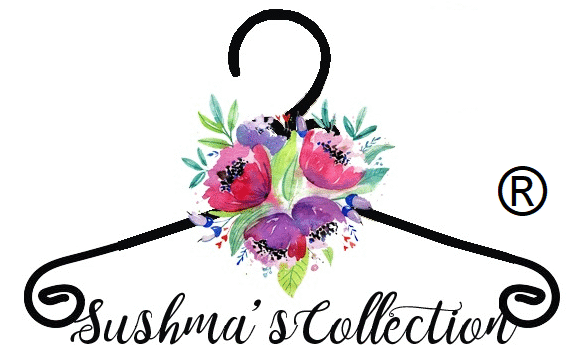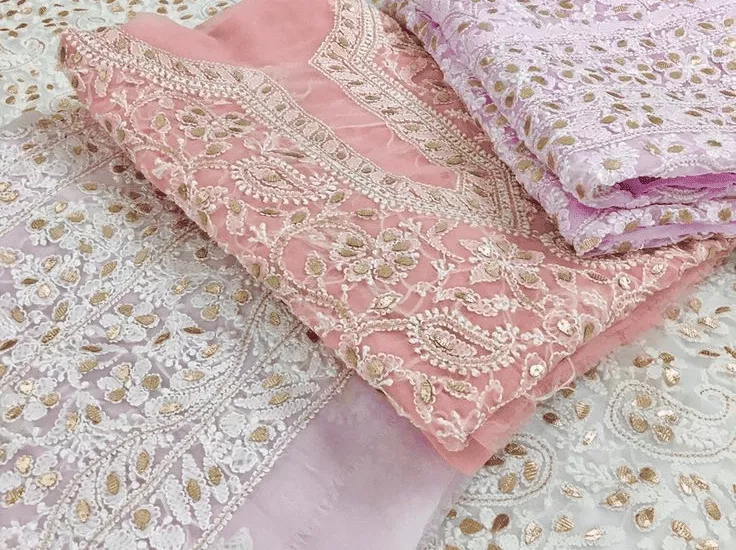Chikan, which means embroidery in Hindi, is believed to have been introduced or popularized by Nur Jahan, the wife of Mughal emperor Jahangir. Originally, Chikankari work was done with white thread on semi-transparent muslin or mulmul cloth. However, due to the emergence of newer fabrics and fashion trends, Chikankari is now also done on a variety of threads and cloth materials. This artwork utilizes various embroidery methods to create beautiful designs, with the use of different strands of threads on fine cloth being a unique feature of Chikankari.
Lucknow, a diverse city in India, is renowned for its love of culture, music, poetry, hospitality, Tehzeeb, handlooms, mouth-watering cuisine, and intricate embroideries. One of its most popular textile decorations is Chikan, a traditional embroidery work that has been passed down through generations since the Mughal era.
The Process of making a Chikankari product
Creating a Chikankari piece is a time-consuming and labor-intensive process, involving three steps: block printing, embroidery, and washing. The first step requires the design to be chosen and engraved onto a wooden block. These blocks are then dipped in dyes or neel and stamped onto the fabric to be embroidered.
Next, the second step involves the needlework itself, as the design is carefully embroidered onto the fabric. Due to the intricate and time-consuming nature of the embroidery, the fabric is fixed into frames to facilitate the process.
Artisans utilize various stitching techniques, depending on the fabric and design, to create the final product.
The last step involves washing the cloth, which is soaked in water before being thoroughly washed to remove any residual ink. Additionally, prior to sale, the fabric is starched to ensure that it retains its intended stiffness.
Types of Stitches
Tepchi stitch is commonly used to outline the motif, and is a simple linear stitch.
Hool stitch involves punching a hole in the cloth and separating the thread. This type of stitch is used to create flower centers.
Bakhiya stitch, also known as ‘Ulti’ or ‘Seedhi’ Bakhiya, is typically used on the inner side of the fabric to create a shadow effect on the outside with borders.
Rahet, also called ‘Dohra Bakhiya’, is often used for outline stitches and creates a solid lining on the right side.
Zanzeera stitch is delicately crafted and highlights the borders of the design.
Jali stitch is a complex form of stitching that requires expertise. The thread is not drawn through the fabric, resulting in a seamless look on both sides of the cloth.
Phanda stitch is a common stitching technique used to create millet-shaped designs, such as flower centers and motifs.
In addition to the previously mentioned stitches, Chikankari also offers a plethora of design options such as Makra, Karan, Sazi, Banjkali, and more. Each of these designs is unique and exceptional, expanding the range of options available.
Fabric Varieties and Colors
Chikankari is a Persian-oriented art and therefore, the motifs and designs made are mostly floral with the addition of stems, leaves, etc. Other than floral, the Paisley motif with a bean-like appearance, has palm leaves, grass stalks, birds and animal motifs like peacocks and butterflies, and geometrical and styled patterned motifs; making the art possibilities limitless. It started with white fabric and white coloured embroidery, however, Chikankari has now crossed the boundaries of basic common colours and is available in both traditional and exotic colour combinations.
Chikankari originated on traditional Muslin fabric, but it has now transitioned to lighter fabrics such as Chiffon, Organza, Cotton, Silk, and Georgette. This is because lighter fabrics require less effort compared to heavier and stiffer fabrics. The availability of multiple fabric options provides flexibility in choosing the fabric that best suits the design and purpose of the Chikankari work.
Type of Products
Chikankari, the exquisite embroidery art form, has gained worldwide recognition and offers a diverse range of clothing products. This traditional craft not only includes clothing items such as Sarees, Kurtas, Dupattas, Tops, Lehengas, Dress Materials, Salwars, Skirts, but also home décor items such as sofa and cushion covers, bed sheets, dining covers, bags, and many more.
Over time, the craft of Chikankari has evolved and adapted to the changing fashion trends, while still maintaining its timeless beauty and exceptional charm. This sustainable art form has withstood the test of time and continues to capture the hearts of people around the world.
.


It is very informative content. Keep posting…